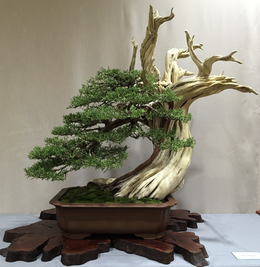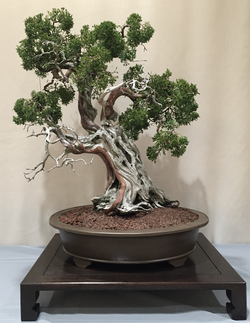Lime Sulfur

By Janet M. Palmer
Warning: Lime sulfur corrosive and must be handled carefully. If splashed into eyes or swallowed seek medical attention immediately. It is recommended you wear chemical-resistant gloves and safety goggles for protection. Read the entire product label before using lime sulfur.
What is Lime Sulfur?
Lime sulfur is a foul smelling liquid that when applied to the deadwood of a bonsai tree produces a distinctive bleaching effect to the deadwood. This bleaching effect is not permanent as lime sulfur exposed to oxygen causes the wood to oxidize back to its natural color so it is recommended to reapply annually. Lime sulfur was originally produced to kill insects, bacteria, and fungi on trees.
How to use Lime Sulfur
It is best to work outside (unpleasant odor) and cover your work surface as lime sulfur will stain anything it comes in contact with. Have an absorbent cloth on hand for spills of excess lime sulfur on the wood.
Warning: Lime sulfur corrosive and must be handled carefully. If splashed into eyes or swallowed seek medical attention immediately. It is recommended you wear chemical-resistant gloves and safety goggles for protection. Read the entire product label before using lime sulfur.
What is Lime Sulfur?
Lime sulfur is a foul smelling liquid that when applied to the deadwood of a bonsai tree produces a distinctive bleaching effect to the deadwood. This bleaching effect is not permanent as lime sulfur exposed to oxygen causes the wood to oxidize back to its natural color so it is recommended to reapply annually. Lime sulfur was originally produced to kill insects, bacteria, and fungi on trees.
How to use Lime Sulfur
It is best to work outside (unpleasant odor) and cover your work surface as lime sulfur will stain anything it comes in contact with. Have an absorbent cloth on hand for spills of excess lime sulfur on the wood.
- First clean and prepare the deadwood.
- The area to be treated should be dampened with water. If lime sulfur is painted on to dry wood, it tends run of the wood instead of being absorbed by the wood. By insuring the wood is damp but not wet, the lime sulfur better penetrates the deadwood (also the moisture is necessary to achieve the desired bleaching effect of the wood). However, excess water on surrounding areas can cause the lime sulfur to rundown the wood and bleach areas not intended to be bleached.
- Pour a small amount of lime sulfur in a dish. Do not apply directly from bottle as it will spoil the mixture.
- Use a paint brush to apply lime sulfur. Match size of brush to size of deadwood to be treated. Do not overload your brush with lime sulfur. It is better to apply several thin coats over a period of hours as a thick coat will cause yellowing. Begin at the highest point of the dead wood. Do not allow lime sulfur to spill into the leaves, bark, or the soil. If there is spillage in surrounding areas, flush with water immediately.

Coloring Lime Sulfur
A stark white finish is not always desirable for all species of trees. Lime sulphur can be tinted with a water-based black ink to produce a more in depth effect to the tree.
A stark white finish is not always desirable for all species of trees. Lime sulphur can be tinted with a water-based black ink to produce a more in depth effect to the tree.
